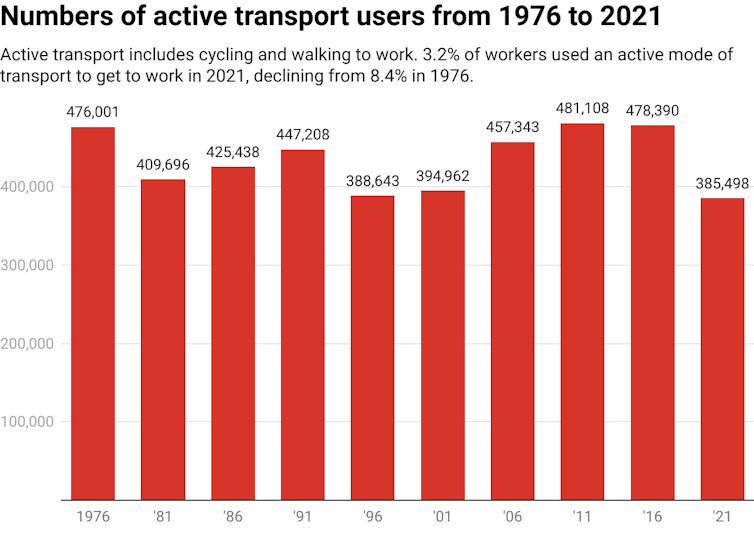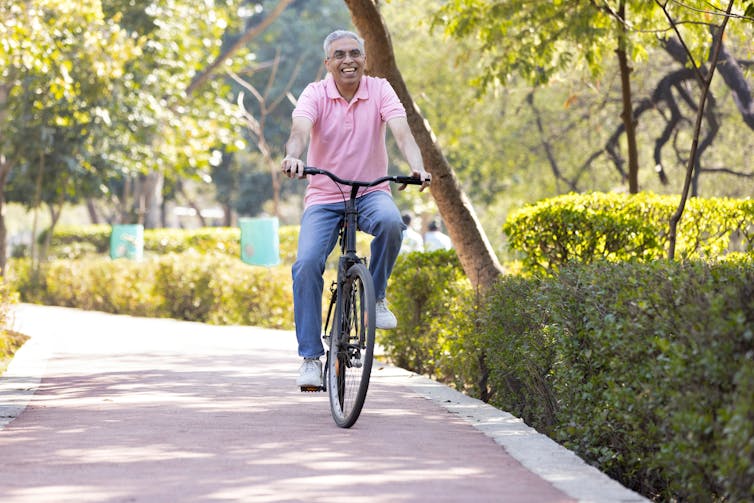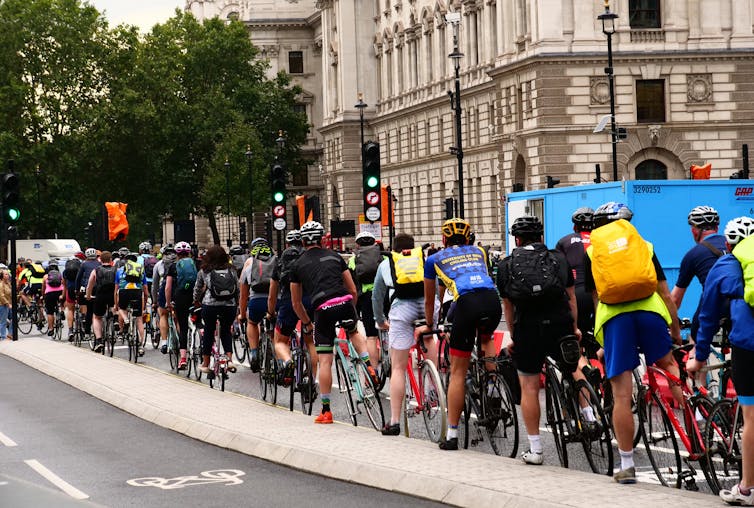 Abdul Razak Latif/Shutterstock
Melanie Davern, RMIT University; Afshin Jafari, RMIT University; Alan Both, RMIT University; Jago Dodson, RMIT University; Lucy Gunn, RMIT University, and Qian (Chayn) Sun, RMIT University
Abdul Razak Latif/Shutterstock
Melanie Davern, RMIT University; Afshin Jafari, RMIT University; Alan Both, RMIT University; Jago Dodson, RMIT University; Lucy Gunn, RMIT University, and Qian (Chayn) Sun, RMIT University
Less than 1% of the 12 million Australians who travelled to work on Census Day in 2021 rode a bicycle to get there.
Bicycles are readily available and affordable. Cycling also supports healthy, liveable and sustainable cities.
Yet most of us shun this form of transport in Australia. The number of people cycling to work fell by 26.4% between 2016 and 2021.
So, on World Bicycle Day, we ask why is this form of transport so undervalued and neglected?
We offer the following ideas about what needs to happen so more of us use bicycles for everyday transport.
 Chart: The Conversation. Data: Australian Bureau of Statistics, Australia's journey to work, CC BY
Chart: The Conversation. Data: Australian Bureau of Statistics, Australia's journey to work, CC BY
1. Improve cycling infrastructure across our cities
Remember the pop-up cycling lanes during COVID and how quickly many of them vanished? With multiple local and state governments managing roads across the country, we have no way of knowing where all the painted or separated cycling lanes currently exist.
Better-connected cycling infrastructure is needed to increase the use of bicycles for transport. At present we don’t understand how well, safely and equitably cycling routes connect up across Australian cities.
2. Use AI to help fill the gaps
Deep-learning artificial intelligence (AI) methods can help pinpoint areas with limited or no cycling infrastructure across the nation. The Australian Urban Observatory will lead a new research project to trial this technology.
AI could help governments identify neighbourhoods lacking cycling infrastructure and end-of-trip facilities, street signs, measure cycling participation and monitor cycling lanes to ensure they’re well marked and maintained. Deep-learning AI is already used to improve cycling performance. It has huge potential to support detailed, cost-effective, real-time identification, management and maintenance of cycling infrastructure.
A big advantage of AI is it can be scaled up. Once trained, AI models can be replicated across many neighbourhoods to identify urban design features that support cycling. It’s even more useful when combined with citizen science and rider experiences, as we plan to do.
This AI technology requires high-resolution satellite imagery and spatial data to identify objects and features. Imagery collected by organisations such as Australia Post, transport departments and road maintenance companies would be perfect for AI analysis. We welcome approaches from potential industry partners for our project.
3. Use simulations to evaluate decisions on cycling
Our cities are growing fast. This creates many challenges, including climate change, traffic congestion, air quality and health. To tackle these challenges, we need evidence to minimise trial-and-error decision-making.
Virtual laboratories can be very useful for evaluating policies and investments before they are put into effect. The key question for decision-makers is where to invest for maximum benefit and minimal harm. Computer transport simulation models can help answer this question.
These models can calculate changes in traffic, cycling uptake and emissions before infrastructure is built. They have traditionally been used to build business cases for infrastructure investment.
However, these models have often neglected cycling. The result is a lack of quantitative, case-specific evidence to support investment decisions on cycling infrastructure.
That’s why we developed the Transport Health Assessment Tools for Brisbane and Melbourne. The results show the health benefits of walking and cycling.
 Policymakers’ decision-making has neglected cycling’s benefits for health, wellbeing and liveability. IndianFaces/Shutterstock
Policymakers’ decision-making has neglected cycling’s benefits for health, wellbeing and liveability. IndianFaces/Shutterstock
4. Plan with a focus on cycling
Australia will have to do more than set up a Net Zero Economy Authority to get to net zero. Electric vehicles won’t solve the problem soon. Transport produces about a fifth of Australia’s emissions but its share is predicted to grow, becoming the largest source of emissions by 2030.
Cycling offers transport that’s almost free, sustainable, time-efficient and healthy. Walking and cycling are no-brainer options to get to net zero sooner.
We can measure basic walkability across neighbourhoods, but where is the connected urban policy support for cycling? We need academics, policymakers and cycling advocates to work together on these problems.
It would be great to see “bicycle mayors” such as Chennai’s Felix John in our cities. Places like the Netherlands and New Zealand give priority to cycling through planning policies and infrastructure such as bike paths and dedicated cycle lanes. The result is high rates of cycling, including children, women and older people who are considered more vulnerable road users.
Australian rates of cycling for transport are dismally low. There’s also a huge gender gap.
 Commuters cycle home from work in London. Joe Kuis/Shutterstock
Commuters cycle home from work in London. Joe Kuis/Shutterstock
5. Make active transport a funding priority
Government infrastructure policies prioritise large, costly road megaprojects, such as Victoria’s A$26 billion North East Link. They entrench many harms of car use, including carbon emissions and other pollution, and displace more active and sustainable forms of travel.
By comparison, walking and cycling infrastructure is cheap and small scale. But to get the greatest benefit it must be broadly spread and connected. We need comprehensive cycling infrastructure plans for our cities that put cycling projects ahead of megaroads for funding.
The federal budget provided an extra $3.2 billion for the over-budget North East Link in Victoria. It announced $100 million for a National Active Transport Fund and a national approach to sustainable urban development.
Halting or deferring funding for massive road projects could free up enough money to transform metropolitan cycling networks. That would support a shift away from cars, creating savings as road projects could be deferred or cancelled.
6. Connect cycling to long-term health benefits
A lack of safe cycling infrastructure denies vulnerable road users the use of this sustainable and healthy transport. This has a long-term and compounding effect: if people don’t take up cycling when young it translates into fewer adult cyclists later. They miss out on being physically active through cycling and its life-long health benefits.
Cycling improves physical and mental health. Some studies suggest cyclists are happier and more productive workers. There’s an incentive for employers to support cycling – even at their desks.
Cycling also benefits children by improving their health, social wellbeing and academic performance.
For all these reasons, cycling is an undervalued mode of transport that needs urgent support. It’s critical for healthy, sustainable and liveable cities of the future.
Melanie Davern, Associate Professor, Director Australian Urban Observatory, Centre for Urban Research, RMIT University; Afshin Jafari, Research Fellow, Centre for Urban Research, RMIT University; Alan Both, Senior Lecturer in Spatial Science, RMIT University; Jago Dodson, Professor of Urban Policy and Director, Urban Futures Enabling Impact Platform, RMIT University; Lucy Gunn, Senior Research Fellow, Healthy Liveable Cities Group, Centre for Urban Research, RMIT University, and Qian (Chayn) Sun, Associate Professor of Geospatial Science, RMIT University
This article is republished from The Conversation under a Creative Commons license. Read the original article.

